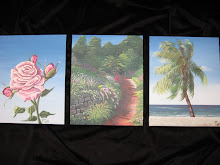Real marble can be extremely expensive. But with faux painting techniques, you can create the look of marble at a price that you can afford. You don't even need to be a professional painter to get great results!
Getting Started
Spend some time looking at pictures of real marble slabs before beginning your faux painting project. This will help you get a better idea of what will work for your surface. These days you don't even have to travel to do that. Just do a search online for "marble" and you can find websites that give you a variety of pictures. There are a number of different methods used to create the look of marble. However, if this is your first faux painting project, intricate designs may be too much to tackle. Additionally, busy patterns can sometimes compete with other elements in the room. If you are going to apply this finish on a wall, then consider a marble look that has less veins that softly blend into one another. Your colors should match the existing room decor.
Tips for Marble Faux Painting Projects
The popular colors used in marble faux painting projects are burnt sienna or dark grey on a pale ivory background. When creating a faux marble finish, you'll need at least two colors of glaze. If you are working with black background, however, shades of white and green are best.
Adding texture to your base coat of glaze can be achieved by lighting dabbing the area with a balled up plastic grocery bag. Tone variations can be created by lifting off excess paint with a natural sea sponge.
Veins can be added to your work with a fine paintbrush, but you may also want to experiment with the different looks provided by making veins with a goose or turkey feather. If you want to make a stencil to guide your work, tear a strip of poster board and paint along the jagged edge.
Consider spending some time perfecting your technique first, on a sturdy sheet of poster board. However, don't be overly critical when trying to correct mistakes in your work. As a natural material, real marble is seldom perfect. Diverse looking veins in regards to thickness and intensity is important. Therefore, even a few minor mistakes can help give your faux painting project a more realistic appearance.
Working with a Faux Painting Kit
For those who are just learning about faux finishing techniques, investing in a faux painting kit can be a smart move. A kit gives you all of the necessary tools in one convenient location, plus detailed instructions to guide you through your home decor project. Even though many home improvement stores are limited in the variety of kits you might find, the internet is a great place to purchase one right for you. There are websites that show you the basics of faux painting which you can incorporate in achieving a faux marble finish, even if it is not included in the kit.
About Author:
Sandy Silva is a professional Faux Painter and Muralist. Her company, Murals & Faux Painting, Inc. in the Miami area has been in business for 20 years and has been dedicated to the decorative wall painting profession for 10 years now. Buy her DVD workshop which comes with 5 tools....one being patent pending. A separate DVD showing how to achieve 4 different marble finishes will be available soon on her website at http://www.muralsandfauxpainting.com/
Article Source: http://EzineArticles.com/?expert=Sandra_Silva
Happy Painting! - Donna of WallDreams *note: Image is a Faux Marble Shelf - Prospect Hill Plantation Inn, Trevillians, Virginia A good tip is to paint faux marble where you would reasonably find marble in real life such as columns, floors, moldings, mantles, fireplaces, walls or countertops where the cost and wear of the surface would not outweigh the price of the real thing. Contemporary as well as classical and traditional design styles are great choices for marbling.
A good tip is to paint faux marble where you would reasonably find marble in real life such as columns, floors, moldings, mantles, fireplaces, walls or countertops where the cost and wear of the surface would not outweigh the price of the real thing. Contemporary as well as classical and traditional design styles are great choices for marbling.
As marble is a clean, smooth stone, so must the prepared surface be.
Do some research on the many different types of marble and how they look - direction of color options, veining, and patterns so that the final faux finish* rings true. (*say that 3 times fast)
If marbling an entire wall, you may want to break the effect into sections or seams of several "blocks" of marble.
Marbling is a layering effect of color taking time, patience and practice to get optimal results.















No comments:
Post a Comment